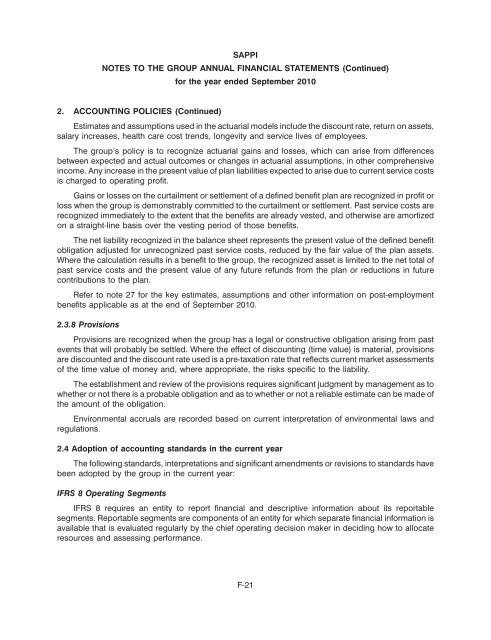Create successful ePaper yourself
Turn your PDF publications into a flip-book with our unique Google optimized e-Paper software.
<strong>SAPPI</strong><br />
NOTES TO THE GROUP ANNUAL FINANCIAL STATEMENTS (Continued)<br />
for the year ended September 2010<br />
2. ACCOUNTING POLICIES (Continued)<br />
Estimates and assumptions used in the actuarial models include the discount rate, return on assets,<br />
salary increases, health care cost trends, longevity and service lives of employees.<br />
The group’s policy is to recognize actuarial gains and losses, which can arise from differences<br />
between expected and actual outcomes or changes in actuarial assumptions, in other comprehensive<br />
income. Any increase in the present value of plan liabilities expected to arise due to current service costs<br />
is charged to operating profit.<br />
Gains or losses on the curtailment or settlement of a defined benefit plan are recognized in profit or<br />
loss when the group is demonstrably committed to the curtailment or settlement. Past service costs are<br />
recognized immediately to the extent that the benefits are already vested, and otherwise are amortized<br />
on a straight-line basis over the vesting period of those benefits.<br />
The net liability recognized in the balance sheet represents the present value of the defined benefit<br />
obligation adjusted for unrecognized past service costs, reduced by the fair value of the plan assets.<br />
Where the calculation results in a benefit to the group, the recognized asset is limited to the net total of<br />
past service costs and the present value of any future refunds from the plan or reductions in future<br />
contributions to the plan.<br />
Refer to note 27 for the key estimates, assumptions and other information on post-employment<br />
benefits applicable as at the end of September 2010.<br />
2.3.8 Provisions<br />
Provisions are recognized when the group has a legal or constructive obligation arising from past<br />
events that will probably be settled. Where the effect of discounting (time value) is material, provisions<br />
are discounted and the discount rate used is a pre-taxation rate that reflects current market assessments<br />
of the time value of money and, where appropriate, the risks specific to the liability.<br />
The establishment and review of the provisions requires significant judgment by management as to<br />
whether or not there is a probable obligation and as to whether or not a reliable estimate can be made of<br />
the amount of the obligation.<br />
Environmental accruals are recorded based on current interpretation of environmental laws and<br />
regulations.<br />
2.4 Adoption of accounting standards in the current year<br />
The following standards, interpretations and significant amendments or revisions to standards have<br />
been adopted by the group in the current year:<br />
IFRS 8 Operating Segments<br />
IFRS 8 requires an entity to report financial and descriptive information about its reportable<br />
segments. Reportable segments are components of an entity for which separate financial information is<br />
available that is evaluated regularly by the chief operating decision maker in deciding how to allocate<br />
resources and assessing performance.<br />
F-21
















